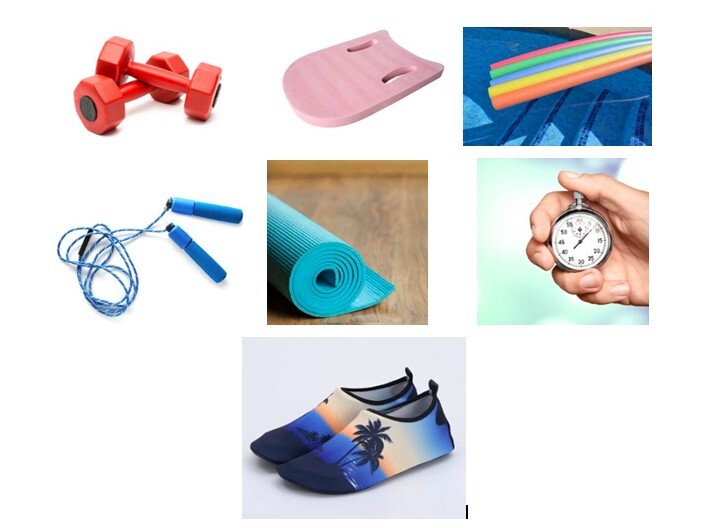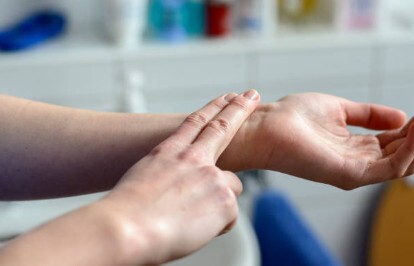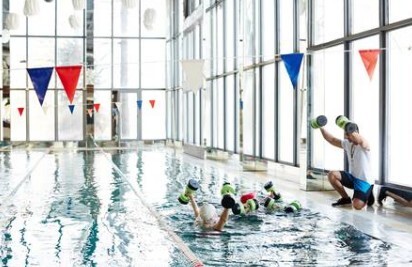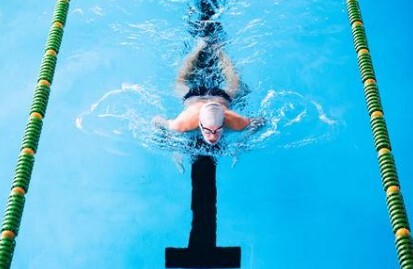Are you looking for a way to super-charge your pool workout, and to vary what you do? Here are some of the best workouts for weight loss in the pool. You will fire up your metabolism in the process!
Regardless of your age, swimming ability, or level, you can adapt these suggestions to get your burn on.
Minimal Skills Needed!
To be able to complete and benefit from a hybrid swim interval workout, you do need to be water-safe. As long as you can either kick on a board, do a side stroke or a similar stroke from one side of the pool to another, you will be good to go!
Also, swimmers of high ability can also benefit from these swimming workouts. They are based on how long your workout is, and your heart rate, rather than how many of the pool exercises you can complete.
Dive in and begin reaching your swimming and weight loss goals!
Overview of Swimming Pool Workouts for Weight Loss
These suggested workouts combine swimming aerobically and anaerobically, with strength and cardio activities in and around the pool.
It is suggested that you start the program with a Sunsational Swim Instructor forprivate swimming lessons at your home or community pool.
You will swim at an easy, medium and accelerated pace. You will activate and work arms, legs, and core. You will be in the pool, on the edge, and out of the pool.
These workouts are beloved by competitive swimmers because they are fun and effective. Get ready!
Suggested Pool Workout Equipment
You will need some workout equipment to help you to achieve your goals. Feel free to improvise with whatever you already have around the house (but no glass, please).
My suggestions are as follows:
2-5 pound medical ball or dumbbell, or soccer-sized ball (a gallon jug of water can work too!)
Kick board
Pool noodle
Jump rope
Yoga mat or similar
Pool shoes
Watch/stopwatch app
Vary Your Heart Rate
There is a lot of talk about interval training, high intensity interval training, etc., and there are enough acronyms describing these types of training to fill a bowl of alphabet soup.
For our purposes, we will keep it relatively simple, using a color scale to describe and track effort levels in your workout.
Normal resting heart rate for adults is around sixty to one hundred beats per minute. To check your resting rate, take your pulse for ten seconds. Your count should be six to ten beats.
Swimming Workout Plan:
Hit all of your colors!
Orange Exercise
In warmup mode, which we will call “orange”, you should count twenty to twenty-two beats during that ten-second pulse.
Start with a short swim, or kick on the noodle or board, for two minutes or so; or do twenty to thirty jumping jacks or jumping slides, or even just the arms motions. Take your ten-second pulse, trying to hit that 20-22 beats mark. If your pulse is still too low, repeat the round.
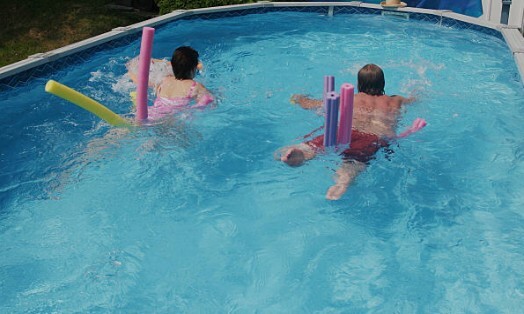
White Zone
Just beyond warm up mode, almost reaching aerobic work, is called the “white” zone. You will count twenty-three to twenty-five heartbeats per ten seconds.
In white zone you will be doing easy, sustained motion. Depending on the size of the pool, your goal will be to do something like two rounds of the following: swim for thirty seconds, rest for fifteen seconds, with eight repeats. Take a minute break after round one, which would be the eighth repeat. Check your pulse after each set of eight.
Try to stay relaxed and almost languid, until you get the feel for what 23-25 beats per minute feels like. There is definitely a learning curve to this process!
Once you have landed solidly in the white zone, sustaining your pulse at 23-25 beats, you can safely head into some hybrid work.
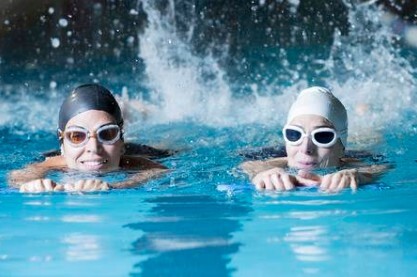
Pink!
In a good aerobic pace mode, hitting your flow, feeling a little burn, your pulse count should be “pink”, at twenty-six to twenty-eight counts per ten seconds.
This zone is a favorite training zone for athletes of all ages and abilities who are trying to build an aerobic base. It is also a little easier to sustain for a long period of time when doing interval training.
And this is where I think it gets to be fun!
Exercise Equipment:
You might want pool shoes and a mat (mat on the deck).
You will also need your kickboard or noodle, soccer-size ball or milk jug or dumbbell, and jump rope.
The combinations are endless, however, let’s start with the base set that you did in the white zone: two rounds, 8x:30 swim or kick, with :15 rest.
Let’s switch the rest to what is known as “working rest”. Instead of doing a set amount of time to rest, we will do a set number of exercises during the non-swim time.
So – start with :30 swimming or kicking. When done, grab the ball and go to the deep end. Hold the ball in the air and position your body vertically. Execute fifty flutter kicks, let go of the ball, and then start your second :30 of swimming.
When done, hop out of the pool and do jump rope thirty times. Get back in, do your :30 swim or kick, and at the shallow end, push your kickboard of noodle straight down and back up in the water twenty times, then let go, and do your next :30 swim.
Add in-pool jumps, step climbing, press outs, situps, squats….anything that you can think of to do between swim repeats. After 8x:30, check your pulse. Let it return to white zone before you start round two.
In the Red
At your highest aerobic mode, your ten-second pulse should be in the twenty-eight to thirty beats range: “red”.
Red mode is similar to pink. However, in this zone, you will increase your time and distance of swimming, as well as your tempo.
For instance, you might try 6x1:00 of swimming or kicking (mix it up if you can!) at a fast pace – small quick kicks, faster tempo and more arm strokes to the pull.
Then, on deck, add in twenty lunges at the same pace as your pink set, or ten jumping jacks at double-speed. Really you can use any activity, but vary them up (for a better workout and to avoid injury).
Let your heart rate return to the pink zone before starting another round in the red!
Blue – Whoo!
Thirty beats or higher in your ten-second count ushers in the anaerobic (“blue”) mode.
If the red zone was comfortable for you, you might want to try the blue zone. If not, give it some time and get very comfortable in the pink and red zones.
Blue swim sets will include swimming faster and shorter than in red – let’s say :45 swim at your fastest speed. Follow with working rest of challenging and explosive activities: repeatedly jumping in and out of the pool (5x is good!), ten burpees, etc.
During a blue set, you will want to take a rest after your activity, count your pulse, and get it back to red, before you do another repeat of :45 swim or kick and explosive activity.
Please note that your actual heart rate might vary a bit from these numbers, and they are simply a guideline. Adjust up or down according to your resting heart rate.
Summary/Guide:
Orange 20-22
White 23-25
Pink 26-28 aerobic
Red 28-30 Aerobic threshold
Blue 30+ anaerobic
Take your time and listen to (and trust) your body. Getting fit is a marathon, not a sprint. Good luck!
Exercises provided by the Sunsational Swim School staff should be done at your own risk with the approval of a medical doctor.
Katie Jenkins’ bio:
Swim instructor in Baltimore, MD
Katie Jenkins is a Sunsational Swim School instructor in the Baltimore Metro area. Katie swam from age six to age twenty-four, and continues to participate in open water races. She has been teaching with Sunsational for a year, and has been a competitive swim coach for over thirty years. She loves being with kids and helping them master new skills!
ABOUT SUNSATIONAL SWIM SCHOOL
Sunsational Swim School is the 🥇 #1 rated provider of private, at-home swimming lessons in America. We have specialized swim instructors for students ages 6 months to adult, beginner to advanced. Featured on ABC, CBS, Impact 100, The List and others, Sunsational instructors have a minimum of 2 years of teaching experience, are CPR certified and insured, and have collectively taught over 302,223 lessons for more than 74,415 students nationwide!


